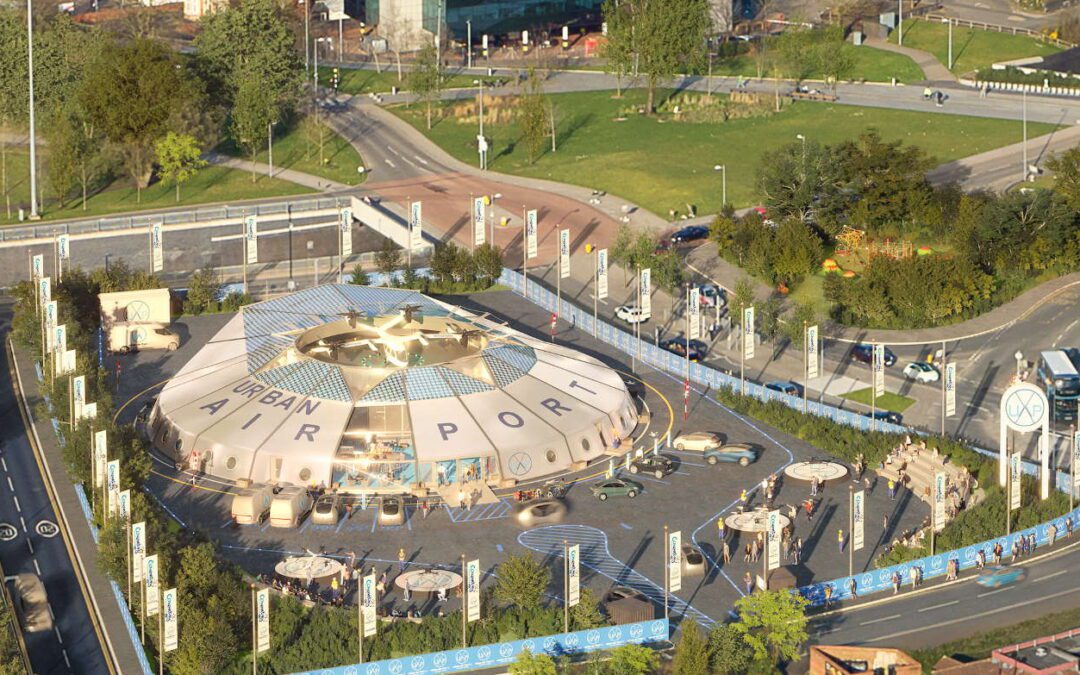“…What is your perception when you think about flying cars? Is it a perpetual cliché that’s only seen in science-fiction movies, that’s actually light-years away in terms of real-life adoption? It’s understandable that society views Urban Air Mobility (UAM) in this way, however, it is a common misconception and a rapidly increasing amount of use-cases, investment and infrastructure being introduced around the globe proves otherwise.
Since February, the first airport specifically for ‘flying taxis’ is being built in Coventry in the UK as a carbon-neutral, zero-emissions hotspot for such means of travel. The vision is that air-taxis or electric vertical take-off and landing (eVTOL) vehicles will provide a platform to transport both people and goods in urban airspace, easing the congestion that we’re so used to being a part of on the ground.
Further to this, The UK Research & Innovation (UKRI) is investing £125 million into its ‘Future flight challenge’ scheme to develop more sustainable methods of flying, but this is just one example of the developments happening within the industry. Sao Paolo in Brazil, known for its heavily-congested road network, is host to the highest concentration of helicopters in the world, and Volocopter, the German
aircraft manufacturer, which is to provide eVTOL’s to France and Singapore in the next three years, are just two of many representative examples illustrating the potential of the market.
The point here is that this is not futurism. It’s not happening in the next 50-years. It’s happening now.
What we are witnessing is drone delivery ‘scaled up’ 100 times to generate the second aviation revolution – and its way more elaborate and progressive than the average person, including those in the industry, recognizes. Aviation firms must jump on the bandwagon and implement necessary business decisions and strategies sooner rather than later, otherwise they risk being left behind in Industry 1.0.
It’s unsurprising that globally, sustainable flying is the vision and companies are seeking the perfect formula to penetrate this potential trillion-dollar market. With the recent United Nations Climate Change Conference (COP 26) addressing current environmental issues and a rising global population, significant emphasis has been placed on the need to save the planet by developing a sustainable ecosystem.
eVTOLs offer completely electric air travel, as well as operating significantly quieter than other alternatives, meeting appropriate environmental standards in terms of fuel and noise pollution. On top of this, the technology can be utilized to transport people and goods at a cheaper cost, therefore improving access, travel times and businesses bottom-lines respectively. Let’s not forget about the amount of added value that can be generated from developments in this space either.
On the other hand, businesses and the general public alike appear to be a setback for implementation in certain cases due to a reticence to trust autonomous flight – as we’ve also seen in the autonomous vehicle market on the ground. Whilst the prospect of flying without a pilot may seem daunting at first and take some persuading, AI and Machine Learning (ML) is becoming more and more visible in the mainstream and by the time air taxis are fully commercialized, consumers will be accustomed to the technology. If we can deliver coffee, sushi and medical supplies to people, why can’t we ‘scale up’ to include humans and cargo? The world’s transport and supply chain logistics certainly need it!
Here at Airwayz, we have received several requests to discuss UAM projects from both public and private companies worldwide looking to prepare for the huge opportunity this second airborne revolution represents. Some of the 100+ companies investing in the sector see technology launched as early as 2025, but that will be for the early adopters. Serious commercial launches could come by 2030.
While that’s still some time off, I urge the industry to prepare now. Where road networks are so often sub-optimal because they were designed for the world of the 1940s, we now have the opportunity to prepare the airspace, the infrastructure for the change that is coming. At some point each ecosystem will be put to the test, making decisions on whether to prioritize medical supplies or air taxis. Let’s not wait for 2030, let’s implement it now for the safe and efficient integration of drones, air taxis and other air vehicles in urban environments.
The ability to manage all air vehicles in the same skies is undeniably important and will allow people, and their businesses, to live better and more efficient lives. With the added sustainability benefits, the opportunities and applications for air taxis are endless and will only improve as AI and ML improve.
Imagine a world where we don’t have the frustration of long traffic jams or delayed services when travelling from city to city. Aerospace firms must act now, as this conceptualization will soon become a realization…”
